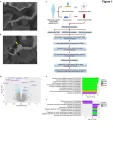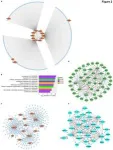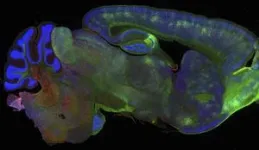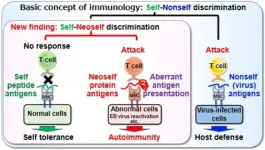(Press-News.org) Mount Sinai researchers have identified a key driver of a blood vessel disorder known as fibromuscular dysplasia (FMD) which affects up to five percent of the adult population and can lead to high blood pressure, heart attack, or stroke.
In a study published September 13 in Nature Cardiovascular Research, the team said changes in the gene UBR4 played an important role as a key driver of FMD. They suggested the discovery could be an important step toward developing a therapeutic approach for the disorder.
“Although fibromuscular dysplasia was first recognized more than 80 years ago, until now very little was known about its causes, pathobiology, or possible treatment,” says Jason Kovacic, MD, PhD, Professor of Medicine (Cardiology) at the Icahn School of Medicine at Mount Sinai and senior author of the study. “By creating the first mouse model we gained critical insights into the processes that trigger FMD, including the role of the protein coding gene UBR4 and its associated gene expression supernetwork which regulates vascular function in the body.”
Fibromuscular dysplasia involves abnormal cell growth in the walls of the arteries, including the carotid, renal, and coronary arteries. Though anyone can develop the condition, it has a distinct sexual bias, affecting women in about 90 percent of cases. Unlike other vascular diseases such as atherosclerosis, FMD is not caused by a build-up of plaque, and many people are unaware they have the disorder. Among the serious medical conditions it can lead to—depending on which artery is affected—are aneurysm (bulging and weakening of the artery), dissection (tearing of the arterial wall), stroke, and heart attack. Restricted blood flow from FMD can also result in high blood pressure, pulsatile tinnitus (whooshing sound in the ears that occurs with each heart beat), and migraine headaches.
Mount Sinai undertook the DEFINE-FMD study to gain a better understanding of this disease, which was suspected of having a strong genetic component. Researchers used skin biopsies from 83 women with FMD as well as from 71 healthy female controls to obtain and grow fibroblast cells, which then underwent gene sequencing to pinpoint the genetic differences between patients and the matched healthy controls. Applying advanced statistical methods known as “systems biology” enabled the scientists to create the first-ever mouse models that recapitulated certain aspects of the disease in humans, and to uncover important insights into its causal pathways and disease drivers.
“These insights included the finding that changes in UBR4 levels—which cause significant changes in the expression levels of other genes in the FMD-associated supernetwork—collectively led to major changes in vascular cell function,” explains co-author Jeffrey W. Olin, DO, Professor of Medicine (Cardiology) at Icahn Mount Sinai and an internationally known expert in the field of vascular medicine. “These alterations in turn led to a demonstrable widening of the arteries in mice, which is one of the features of FMD in humans.”
By identifying a gene and its gene regulatory network that appear to account for a significant portion of FMD heritability, scientists believe they have taken a major step toward a therapeutic solution. "Our study opens the door to targeted modulation of UBR4 and its disease-relevant gene regulatory network, and that could hold tremendous promise for the many people, particularly women, with this condition,” emphasizes Dr. Kovacic. “These exciting findings are encouraging us to continue our work with colleagues around the world to shed further light on a disease which until now was largely a blank slate.”
Funding for this study was supported by grants from the National Heart, Lung, and Blood Institute at the National Institutes of Health and additional philanthropic support.
Mount Sinai Is a World Leader in Cardiology and Heart Surgery
Mount Sinai Fuster Heart Hospital at The Mount Sinai Hospital ranks No. 1 in New York and No. 4 nationally for cardiology, heart, and vascular surgery, according to U.S. News & World Report®. It also ranks No. 1 in New York and No. 6 globally according to Newsweek’s “The World’s Best Specialized Hospitals.”
It is part of Mount Sinai Health System, which is New York City's largest academic medical system, encompassing eight hospitals, a leading medical school, and a vast network of ambulatory practices throughout the greater New York region. We advance medicine and health through unrivaled education and translational research and discovery to deliver care that is the safest, highest-quality, most accessible and equitable, and the best value of any health system in the nation. The Health System includes approximately 9,000 primary and specialty care physicians; 11 free-standing joint-venture centers throughout the five boroughs of New York City, Westchester, Long Island, and Florida; and 39 multidisciplinary research, educational, and clinical institutes. Hospitals within the Health System are consistently ranked by Newsweek’s® “The World’s Best Smart Hospitals” and by U.S. News & World Report's® “Best Hospitals” and “Best Children’s Hospitals.” The Mount Sinai Hospital is on the U.S. News & World Report's® “Best Hospitals” Honor Roll for 2024-2025.
For more information, visit https://www.mountsinai.org or find Mount Sinai on Facebook, Twitter and YouTube.
END
Scientists discover potential cause of an enigmatic vascular disease primarily impacting women
2024-09-13
ELSE PRESS RELEASES FROM THIS DATE:
Stimulant, antidepressant, and opioid telehealth prescription trends between 2019 and 2022
2024-09-13
About The Study: From 2019 to 2022, overall prescription volumes for stimulant and antidepressant medications increased, while prescription volume for opioids decreased. Concurrently, the proportion of telehealth prescriptions climbed across medications, increasing by a factor of 188 in opioids and more than 20 for antidepressants. These findings align with existing research highlighting the shift toward telehealth and the rise in stimulant and opioid telehealth prescribing during the pandemic. While in-person prescribing remains the most common, increasing telehealth ...
One-year weight reduction with semaglutide or liraglutide in clinical practice
2024-09-13
About The Study: In this retrospective cohort study of 3,389 patients with obesity, weight reduction at 1 year was associated with the medication’s active agent, its dosage, treatment indication, persistent medication coverage, and patient sex. Future research should focus on identifying the reasons for discontinuation of medication use and interventions aimed at improving long-term persistent coverage.
Corresponding Author: To contact the corresponding author, Hamlet Gasoyan, PhD, email gasoyah@ccf.org.
To access the embargoed study: Visit our For The Media ...
Adolescents and young adults’ sources of contraceptive information
2024-09-13
About The Study: This study’s results suggest discrepancies between preferred and actual sources of contraceptive information for assigned female at birth adolescents and young adults in the U.S. Findings underscore the role of clinicians in supporting informed contraceptive decision-making among adolescents and young adults. Clinicians were the most commonly preferred source, and receiving information from them was associated with having sufficient information to choose a contraceptive method; however, clinicians were the source with the largest discrepancy between preferred and actual use.
Corresponding Author: To contact the corresponding author, ...
Health warnings on Instagram advertisements for synthetic nicotine e-cigarettes and engagement
2024-09-13
About The Study: In this cross-sectional study of synthetic nicotine brand Instagram accounts, 87% of sampled posts did not adhere to FDA health warning requirements in tobacco promotions. Enforcement of FDA compliant health warnings on social media may reduce youth engagement with tobacco marketing.
Corresponding Author: To contact the corresponding author, Traci Hong, PhD, email tjhong@bu.edu.
To access the embargoed study: Visit our For The Media website at this link https://media.jamanetwork.com/
(doi:10.1001/jamanetworkopen.2024.34434)
Editor’s Note: Please see the article for additional information, including ...
Cleveland Clinic study identifies key factors that can impact long-term weight loss in patients with obesity who were prescribed GLP-1 RA medications
2024-09-13
UNDER EMBARGO Friday, September 13, 2024, 11 a.m. ET, CLEVELAND: A Cleveland Clinic study identified key factors that can impact the long-term weight loss of patients with obesity who were prescribed injectable semaglutide or liraglutide for the treatment of type 2 diabetes or obesity. The study was published in JAMA Network Open.
“In patients with obesity who were prescribed semaglutide or liraglutide, we found that long-term weight reduction varied significantly based on the medication’s active agent, treatment indication, dosage and persistence with the medication,” said Hamlet Gasoyan, Ph.D., lead author of the study ...
Neoself-antigens induce autoimmunity in lupus
2024-09-13
Osaka, Japan – Autoimmune diseases are widespread and notoriously difficult to treat. In part, this is because why the immune system attacks its own tissues in patients with these conditions remains poorly understood.
In a study recently published in Cell, researchers from Osaka University have revealed that the body’s own proteins with unusual structure trigger immune cells to unleash a wave of inflammation that leads to autoimmunity.
Autoimmune diseases develop when the body’s immune system mistakenly attacks its own tissues instead of fighting off foreign invaders like bacteria or viruses. However, it has long been a mystery why this happens, as ...
New therapy that targets and destroys tau tangles is a promising future Alzheimer’s disease treatment
2024-09-13
Scientists have developed new potential therapies that selectively remove aggregated tau proteins, which are associated with Alzheimer’s disease, and improve symptoms of neurodegeneration in mice.
The team of scientists, from the Medical Research Council Laboratory of Molecular Biology (MRC LMB) in Cambridge, UK, and the UK Dementia Research Institute (UK DRI) at the University of Cambridge, say this promising approach could also be applied in future to other brain disorders driven by protein aggregation inside cells, ...
Study finds ‘supercharging’ T cells with mitochondria enhances their antitumor activity
2024-09-13
Fighting cancer is exhausting for T cells. Hostile tumor microenvironments can drain their mitochondrial activity, leading to a condition known as T cell exhaustion. This phenomenon also hinders adoptive cell therapies, in which healthy, tumor-targeting T cells are infused into patients with cancer. A novel method to boost mitochondrial activity and charge up T cells is needed.
Investigators from Brigham and Women’s Hospital, a founding member of the Mass General Brigham healthcare system, in collaboration with colleagues at Leibniz Institute for Immunotherapy in Germany, have developed a way to “supercharge” T cells by supplying them with extra mitochondria ...
Harnessing the power of porosity: A new era for aqueous zinc-ion batteries and large-scale energy storage
2024-09-13
As the global demand for energy storage solutions grows, the limitations of current lithium-ion batteries, such as safety concerns and high costs, have driven the exploration of alternative technologies. Aqueous zinc-ion batteries (AZIBs) have emerged as a promising candidate due to their inherent safety, cost-effectiveness, and environmental sustainability. However, challenges like zinc dendrite growth continue to hinder their widespread adoption. Due to these challenges, there is a pressing need to delve deeper ...
Antibody-drug conjugate found effective against brain metastases in patients with HER2-positive breast cancer
2024-09-13
Trastuzumab deruxtecan shows substantial anti-cancer activity in brain metastases in patients with HER2-positive breast cancer in major international clinical trial
Results confirm findings of previous, smaller studies
BARCELONA, Spain - A drug that delivers chemotherapy directly to tumors has shown impressive activity against some of the hardest-to-reach cancer cells: those that have spread to the brain in patients with advanced HER2-positive breast cancer. The findings, from an international clinical trial led by Dana-Farber Cancer Institute researchers, reinforce earlier findings of the benefits ...







